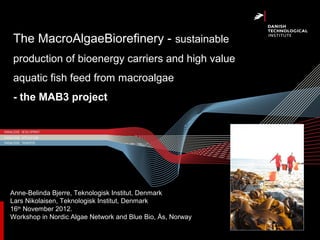
Nic mab3 project ås 16.11.12
- 1. The MacroAlgaeBiorefinery - sustainable production of bioenergy carriers and high value aquatic fish feed from macroalgae - the MAB3 project Anne-Belinda Bjerre, Teknologisk Institut, Denmark Lars Nikolaisen, Teknologisk Institut, Denmark 16th November 2012. Workshop in Nordic Algae Network and Blue Bio, Ås, Norway
- 2. Algae More than 1500 species in More than 1500 species in the Danish sea waters all the Danish sea waters all with different chemical with different chemical compositions. compositions.
- 3. The MacroAlgaeBiorefinery : MAB3 Title: Sustainable production of 3G energy carriers (ethanol, butanol og biogas) and fish feed from macroalgae (Laminaria digitata and Saccharina latissima) Project period: 1st of March 2012 - 1st of March 2016 Financied by the Danish Strategic Research Council (20,4 mill. DKK total budget på 24 mill. DKK) 12 Partnere from Denmark, Irland, Italy, Germany Education of 4 ph.d. and 2 post docs Coordinator: Danish Technological Institute v/ Anne-Belinda Bjerre
- 4. Partners Danish Technological Institute (Coordinator) Aarhus University (AaU) (2 institutes) Technical University of Denmark (DTU) (2 institutes) National University of Ireland, Galway University of Hamburg University of Siena Danish Shellfish Centre Orbicon A/S DONG Energy A/S Aller Aqua A/S Vitalys I/S Dangrønt Products A/S Novozymes participates as affiliated partner (delivery of enzymes and participating in the advisory board)
- 5. Biorefinery Definition: Integrated and combined processes for the conversion of biomass into a variety of food, feed, chemicals, biomaterials, and energy – at the same time maximising the value of the biomass and minimising the waste
- 6. Transportation fuel from algae Macroalgae: High contents of carbohydrates (45-65%) Microalgae: High contents of lipids (25- 35%)
- 7. History of bio-ethanol (fuel ethanol) production in USA , the driver in biorefinery development Ethanol Production in US 12000 10000 Millon of Gallons per Year All 1G ethanol 8000 6000 4000 2000 0 80 82 84 86 88 90 92 94 96 98 00 02 04 06 08 10 19 19 20 19 19 19 19 19 19 19 19 20 20 20 20 20
- 8. In MAB3, fish feed (protein) will be the value added product, In MAB3, fish feed (protein) will be the value added product, derived from production of energy carriers e.g. ethanol or derived from production of energy carriers e.g. ethanol or biogas biogas
- 9. Introduction to MAB3 Hypothesis: 1) Two brown macroalgae can be upgraded to energy carriers (either bioethanol, buthanol or biogas or combinations hereof) by conversion of 80% of the fermentable sugars, leaving behind a concentrated solid fraction rich in protein and (for liquid biofuels also) lipids, which can be used for fish feed. 2) A substantial amount (90%) of the remaining, undigested sugars i.e. the C5 sugars can be converted to additional value-added amino acids (isoleucine and arginine) for fish feed supplement. The project Best practical methods, processes and technologies will be tested Best practical methods, processes and technologies will be tested and optimised to meet these goals and optimised to meet these goals
- 10. MAB3: Financed by the Danish Strategic Research Counsil WP1: Cultivation and WP8: harvesting Management WP2: Pretreatment and storage WP3: Liquid biofuels. WP4: Gaseous biofuel Ethanol and butanol and amino acids WP5: Fish feed WP6: Sustainability and feasibility WP7: Dissemination
- 11. How brown algae are composed Brown Algae lack real, distinct, secondary cell walls (no lignin). The cell walls in brown algae thalli are made up mainly of cellulose “micro- fibrils” or fibrils forming a felty network. The fibrils are rarely ordered in parallel manner as in higher plants or even some green algal species. In brown algae, these felty fibre networks are layered and embedded in a polysaccharide matrix. Gentle pretreatment technologies will be needed for disrupting the biomass before enzyme hydrolysis
- 12. Production of ethanol (or butanol) and protein from algae biomass Ethanol fermenting strains Protein (s) Ethanol (l)
- 13. Auger pressing of Laminaria digitata from August harvest 2012
- 14. Ethanol production from Chaetomorpha linum testing different pretreatment conditions Schultz-Jensen et al 2012, in preparation Ball milling most Ball efficient milling most pretreatment efficient method for pretreatment ethanol method for production ethanol (19 g/100g) production (19 g/100g)
- 15. Conclusions: Brown algae are fine substrates for ethanol production due to high contents of polysaccharides. Challenges are: – Identification of most suitable enzyme mixtures for fully hydrolysis to monomeric sugars Washing and auger pressing were efficient pretreatment methods for water and salt removal in green algae, new test on brown algae have been performed. – Room for improvement e.g. by enzyme treatment. Brown algae lack real, distinct, secondary cell walls (no lignin). – Pretreatment conditions (prior to enzymatic hydrolysis) are less severe than for lignocellulosic biomass materials: Ball milling was the most effective pretretment of Chatamorpha linum prior to SSF with Baker’s yeast fermentation in combination with Celluclast and Novozym 188. – Improved yields are expected using more targeting enzymes and other microorganisms during fermentation.
- 16. Acknowledgements Danish Strategic Research Council, Programkomiteen for Bæredygtig Energi og Miljø, for financial support Project partners for co-financing the project Novozymes for delivery of enzymes and chairing the advisory board
- 17. Thank you for your attention Web-site about MAB3 www.mab3.dk Contacts about MAB3: Anne-Belinda Bjerre: ANBJ@dti.dk Karin Svane Bech: kasb@dti.dk Lars Nikolaisen: LSN@dti.dk Annette Bruhn: anbr@dmu.dk
Hinweis der Redaktion
- 2nd Danish Macro Algae conference and workshop
- Søsalat, blæretang, Laminaria, Spirulina, Dunaliella, Chlorella 2nd Danish Macro Algae conference and workshop
- 2nd Danish Macro Algae conference and workshop